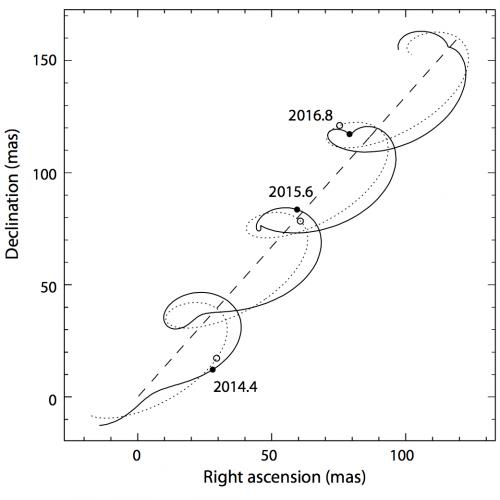Astrometry
Astrometry is the science of making precise measurements of the position of an object in the night sky.
Unlike places on Earth, objects in the night sky appear to move over time. This is because the Earth rotates on its axis and orbits the Sun. So astronomers use special systems of coordinates which take this into account. One of the most common celestial coordinate systems uses Right Ascension and Declination. These names are usually shorted to RA and Dec.
Knowing the exact position of a star allows astronomers to look for small changes in its coordinates. If a star appears to 'wobble', this may be due to a nearby planet. But why does this happen? Let's think about our own Solar System.

Credit: ESA (European Space Agency)
You may know that everything in our Solar System orbits the Sun. But that is not quite true. Everything in our Solar System orbits the centre of all the mass in our Solar System. The Sun also orbits around this centre of mass, which gives it a very small wobble. However, since the vast majority of our Solar System's mass is in our Sun, the effect is quite small.
We can use this knowledge when we look for exoplanets. The amount that a star wobbles, is related to the mass, number, and proximity of its planets. A higher planet-to-star mass ratio produces a more noticeable wobble. This is because as this ratio increases, the centre of mass shifts out from the centre of the star. A planet with a longer orbit also produces a bigger shift in the centre of mass.
Of course, many stars can be seen to move against a fixed background of stars and galaxies. If we see repeated changes in a star's position over time, then we can say the effect is due to an exoplanet.
Astrometry is a good method for finding exoplanets that (from our viewpoint on Earth) do not cross in front of their star. It can also be used to find planets located at large distances from their star. This makes astrometry a good method for looking for Earth-like exoplanets.
So far, this method has only found a handful of exoplanets. However, it is a useful way to confirm the presence of previously discovered exoplanets.
We can also use astrometry to work out the mass of an exoplanet. Plus it gives more accurate results than the radial velocity method. In 2018 astrometry data was used to show that exoplanet beta Pictoris b had a mass of 11±2 Jupiter masses. This value agreed well with an estimate of the minimum mass of the planet of around 13 Jupiter masses.

